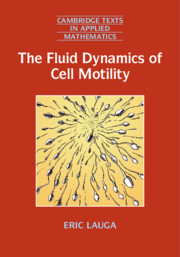Crossref Citations
This Book has been
cited by the following publications. This list is generated based on data provided by Crossref.
Gallagher, M. T.
and
Smith, D. J.
2021.
The art of coarse Stokes: Richardson extrapolation improves the accuracy and efficiency of the method of regularized stokeslets.
Royal Society Open Science,
Vol. 8,
Issue. 5,
p.
210108.
Fortune, George T.
Worley, Alan
Sendova-Franks, Ana B.
Franks, Nigel R.
Leptos, Kyriacos C.
Lauga, Eric
and
Goldstein, Raymond E.
2021.
The fluid dynamics of collective vortex structures of plant-animal worms.
Journal of Fluid Mechanics,
Vol. 914,
Issue. ,
Ferrer, Brandon R.
Gomez-Solano, Juan Ruben
and
Arzola, Alejandro V.
2021.
Fluid Viscoelasticity Triggers Fast Transitions of a Brownian Particle in a Double Well Optical Potential.
Physical Review Letters,
Vol. 126,
Issue. 10,
Junot, Gaspard
Cebers, Andrejs
and
Tierno, Pietro
2021.
Collective hydrodynamic transport of magnetic microrollers.
Soft Matter,
Vol. 17,
Issue. 38,
p.
8605.
Yasuda, Kento
and
Komura, Shigeyuki
2021.
Nonreciprocality of a micromachine driven by a catalytic chemical reaction.
Physical Review E,
Vol. 103,
Issue. 6,
Liao, Weida
and
Lauga, Eric
2021.
Energetics of synchronization for model flagella and cilia.
Physical Review E,
Vol. 103,
Issue. 4,
Tian, Fang-Bao
and
Wang, Li
2021.
Numerical Modeling of Sperm Swimming.
Fluids,
Vol. 6,
Issue. 2,
p.
73.
Jiang, Weiquan
and
Chen, Guoqian
2021.
Transient dispersion process of active particles.
Journal of Fluid Mechanics,
Vol. 927,
Issue. ,
Shaik, Vaseem A.
and
Elfring, Gwynn J.
2021.
Hydrodynamics of active particles in viscosity gradients.
Physical Review Fluids,
Vol. 6,
Issue. 10,
Daddi-Moussa-Ider, Abdallah
Löwen, Hartmut
and
Liebchen, Benno
2021.
Hydrodynamics can determine the optimal route for microswimmer navigation.
Communications Physics,
Vol. 4,
Issue. 1,
Gaffney, Eamonn A.
Ishimoto, Kenta
and
Walker, Benjamin J.
2021.
Modelling Motility: The Mathematics of Spermatozoa.
Frontiers in Cell and Developmental Biology,
Vol. 9,
Issue. ,
Esparza López, Christian
Gonzalez-Gutierrez, Jorge
Solorio-Ordaz, Francisco
Lauga, Eric
and
Zenit, Roberto
2021.
Dynamics of a helical swimmer crossing viscosity gradients.
Physical Review Fluids,
Vol. 6,
Issue. 8,
Ohm, Laurel
2021.
Remarks on Regularized Stokeslets in Slender Body Theory.
Fluids,
Vol. 6,
Issue. 8,
p.
283.
Angeles, Veronica
Godínez, Francisco A.
Puente-Velazquez, Jhonny A.
Mendez-Rojano, Rodrigo
Lauga, Eric
and
Zenit, Roberto
2021.
Front-back asymmetry controls the impact of viscoelasticity on helical swimming.
Physical Review Fluids,
Vol. 6,
Issue. 4,
Théry, Albane
Wang, Yuxuan
Dvoriashyna, Mariia
Eloy, Christophe
Elias, Florence
and
Lauga, Eric
2021.
Rebound and scattering of motile Chlamydomonas algae in confined chambers.
Soft Matter,
Vol. 17,
Issue. 18,
p.
4857.
Moreau, Clément
and
Ishimoto, Kenta
2021.
Driving a Microswimmer with Wall-Induced Flow.
Micromachines,
Vol. 12,
Issue. 9,
p.
1025.
Velho Rodrigues, Marcos F.
Lisicki, Maciej
Lauga, Eric
and
Lele, Pushkar P
2021.
The bank of swimming organisms at the micron scale (BOSO-Micro).
PLOS ONE,
Vol. 16,
Issue. 6,
p.
e0252291.
Grisolia, Giulia
and
Lucia, Umberto
2022.
Why does thermomagnetic resonance affect cancer growth? A non-equilibrium thermophysical approach.
Journal of Thermal Analysis and Calorimetry,
Vol. 147,
Issue. 9,
p.
5525.
Hrishikesh, Bhadra
Takae, Kyohei
Mani, Ethayaraja
and
Tanaka, Hajime
2022.
Phase separation of rotor mixtures without domain coarsening driven by two-dimensional turbulence.
Communications Physics,
Vol. 5,
Issue. 1,
Asadzadeh, S. S.
Walther, J. H.
Andersen, A.
and
Kiørboe, T.
2022.
Hydrodynamic interactions are key in thrust-generation of hairy flagella.
Physical Review Fluids,
Vol. 7,
Issue. 7,



